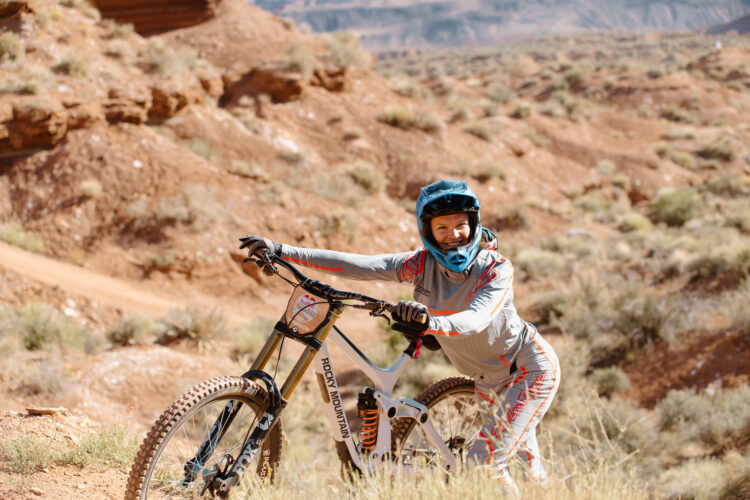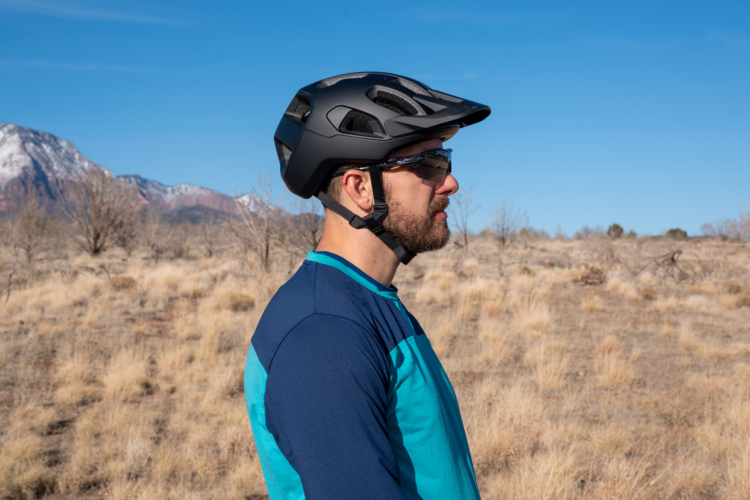
Now in her 17th season with the famed Santa Cruz Syndicate gravity squad, team manager Kathy Sessler carries on with her uniquely familial level of support and encouragement. The legendary mountain biker and actress turned team manager digs in deeper than your average World Cup team staff, and her efforts have produced a crew of successful riders who sign on for the long haul.
Sessler’s relationship with our beloved sport caught fire in 1972 during the early days of BMX racing. At the impressionable age of fourteen, Sessler saw Bruce Brown’s now famous motorcycle documentary, On Any Sunday, and her interest in going fast on two wheels was piqued. She quickly began building jumps and promoting BMX races in her hometown of Seal Beach, California. If you’re intrigued by Sessler’s BMX history you can spend a full weekend in that internet wormhole.
At my track I dug the water holes, made the berms, and built the jumps. The biggest was an entire 18 inches high. I made flag banners out of red, white, and blue crepe paper and stapled them to string around the track. I made paper plate number plates with our local motocross hero’s numbers on them. Many kids around the world were doing the same thing, but what set me apart from the rest is that I grabbed my dad’s 8mm movie camera and took movies of my races. I have about 20 minutes of footage. This historic footage can be seen on the Sprung 5 DVD, and [it features] Joe Kid on a Sting Ray.
Mountain biking entered Sessler’s life in 1990, when the then 32-year-old newlywed rolled into the trails above their home in Murrieta, California on her husband’s $50 mountain bike.
I raced my first race at the Fall Classic at Big Bear that year and then raced the California State Championship Series in 1991. In 1992 I raced downhill in the Pro class and raced pro downhill until World Champs in 1997, which was my last race. I was a 3-time National Champ Veteran Women in 1992, 1993, and 1994. I was a World Championship Veteran Women’s Silver medalist in 1992, Bronze in 1994, and Gold in 1996. In two other World Championships (’93 & ’95), I was the fastest veteran woman in the Senior’s race, but our class was disqualified due to only 4 countries being represented instead of the required 5.
I was the first pro to ever race an Intense Cycles frame. Jeff Steber made the frame on his kitchen table for me. I was the first Maxxis girl. I was also the first pro to ever race the Intense M-1, and that first race was the 10th place finish at the UCI World Cup in Mammoth in 1994.
In 1997, while still racing, Sessler started a second career as a bicycle stunt double in a TV show called Pacific Blue, along with several B-movie roles. It’s clear she lives for a thrill and knows how to rally a fun party in the midst of a lot of hard work, which made her transition to managing downhill teams a fluid one. Sessler recently gave us a peek behind the Syndicate curtain, and we are happy to share her story with you.

What does a regular day in your job look like during the “off season?”
I’m am fortunate that I get to work from my home office. I live in Southern California so I don’t work up at Santa Cruz HQ. So a regular day would start with emails, as dealing with all time zones interesting things come in overnight. After the season I spend a lot of time working on year-end projects. I make a season photobook that all the sponsors and team members receive. I also make a year-end report with results, media, and social media exposure and anything else interesting to let our sponsors know how we did for the year.
I start planning for the upcoming season and all of our team accommodations are booked probably by October.
There is still usually an event or appearance, or testing that needs to be done at the end of the season that I’ll plan logistics for. I work with our mechanics to plan for the tasks that need accomplishing to trucks, equipment, or things of that nature to complete before the season starts.

What is unique about the Syndicate?
The Syndicate is a group of individuals under the banner of the Syndicate. We are a family more than a team. We aim to honor each person’s individuality and support each in their unique gifts to achieve their best performances. Everyone genuinely likes one another and there are occasional disagreements, which we work through like any family. I think this approach reflects Rob Roskopp’s, and my values.

Who determines team roster selection and what factors go into those picks?
This is mostly done by Rob Roskopp. The team members can have some input, but ultimately Rob signs off on it. Keep in mind that we’ve only had six riders in 16 years…so not of a lot of opportunity for people to join. Factors that we look at are the athletes’ ability to win races, good and marketable personalities, unique identities, loyal and ethical traits, the type of person you want to add to your family.
Where does the team’s funding come from?
Santa Cruz Bicycles funds the bulk of the budget. We get generous support from our major sponsors, Fox Racing, Shimano, Maxxis, and Burgtec. We have product sponsors and lower-tier sponsors that also contribute greatly to the team.

What are some of the impacts you and your team have had on the sport?
I have to say that the original team members with Rennie, Peaty, Minnaar, and Ratboy were some golden years. With their big personalities and winning ways Syndicate left a unique impression that will never be forgotten.
- We were the first team to run full carbon bike and wheels when Greg won the race in Maribor back in 2010.
- We were the last team to win a race on 26” wheels with Ratboy winning in Monte Sainte Anne in 2015.
- We were the first team to race 29” wheels in Lourdes in 2017.
- We’ve made an impact on clothing design restrictions in world cup races when we weren’t able to conform to the elite trade team rules in 2015. I tried to align with the requirements but when we couldn’t, I had to stand up for the practicality of the individuality of the athlete to run their choice of race kit. (https://notatradeteam.com)
How does the sponsor selection happen?
Santa Cruz does all the choosing and negotiations. Obviously we align with great product sponsors so we have the best equipment possible, so that is part of the choosing of sponsors.

What was the funniest moment on the team in 2019?
For me it has to be when Loris dressed up as Freddie Mercury at the Les Gets world cup. I remember when we started realizing that Loris looked a lot like Rami Malek the actor who played Freddie Mercury in the movie Bohemian Rhapsody. I got the idea to get a complete outfit for Loris, just in case he’d be keen at some point to dress up as Freddie. I order replica teeth, a mustache, and wardrobe and just waited for the right time. In Les Gets a ton of Santa Cruz folks were in town and we were having a gathering in our pit after the race. It seemed like the perfect time and Loris pulled it off. I laughed so hard, especially when we were trying everything on to see if it all fit, and to mold the teeth to his mouth.
What is something that you do differently from other team managers you know?
I probably am a better cook than most of them, although Gabe Fox (the Canyon racing manager), does a lot of cooking for his team, we’ve never had a cook off. Of course being a woman and a mother I tend to look after the group in a maternal way. I aim to sense and perceive the nuances of the individuals and balance and harmonize the team where I can. I have been accused of being too soft, but I try to see what is unfolding and go with the flow rather than trying to be too strict. I think we can get the most out of people if their strengths and styles are recognized and encouraged, rather than have them fit an expectation.
- I make a Christmas dinner, usually at Ft. William, where I get a tree, funny presents, and we have a lot of laughs.
- I sew alterations for the guys’ race pants and jerseys when needed.
- And I wash the guys’ clothes. I don’t know other managers who do this, haha.

Is there a part of the job that’s “just a job?“
Yes, definitely doing expense reports. It’s super tedious and not creative. I prefer to be planning logistics, putting flights and ground travel together, being in the outdoors. That part suits me more than the office work.
How long have you been working with the Syndicate, or with other teams?
I’ve been working with the Syndicate from its inception in 2004, so going into my 17th year leading the team.
After retiring from downhill racing in 1997, I started doing team management for Intense Cycles in 1999 thru 2002. Jeff Steber, owner of Intense Cycles, and I have been friends for years and we live in the same town. It was only natural that I took my knowledge of travel, racing, of athletes and organizational skills, and put them to use to help manage Jeff’s team. In 2003 Derin Stockton (my former teammate from the Maxxis/Outland team), started a team, which was Intense Tires/Santa Cruz. He asked me to be his team manager.
In 2004 Rob Roskopp, owner of Santa Cruz Bicycles, took over the team in its entirety, rather than just being a frame sponsor. The Santa Cruz Syndicate evolved from the team Derin started. I love managing the team because it allows me to keep vibrant and do creative things, from the travel, interacting with the riders, to developing more skills that help me do better job (such as photography that I use in my race reports). I am also able to stay involved in the sport that I love so much and I get to experience the racing excitement without any risk myself! I love the travel and I take great satisfaction in watching my athletes work so hard to be their very best.

You can keep up with Sessler and her Syndicate family throughout the 2020 season on their social media pages, as well as the team’s UCI results page. In closing, we would like to thank Kathy Sessler for taking the time to share her story, and for working to make our awesome sport better year after year.




















1 Comments
Feb 11, 2020